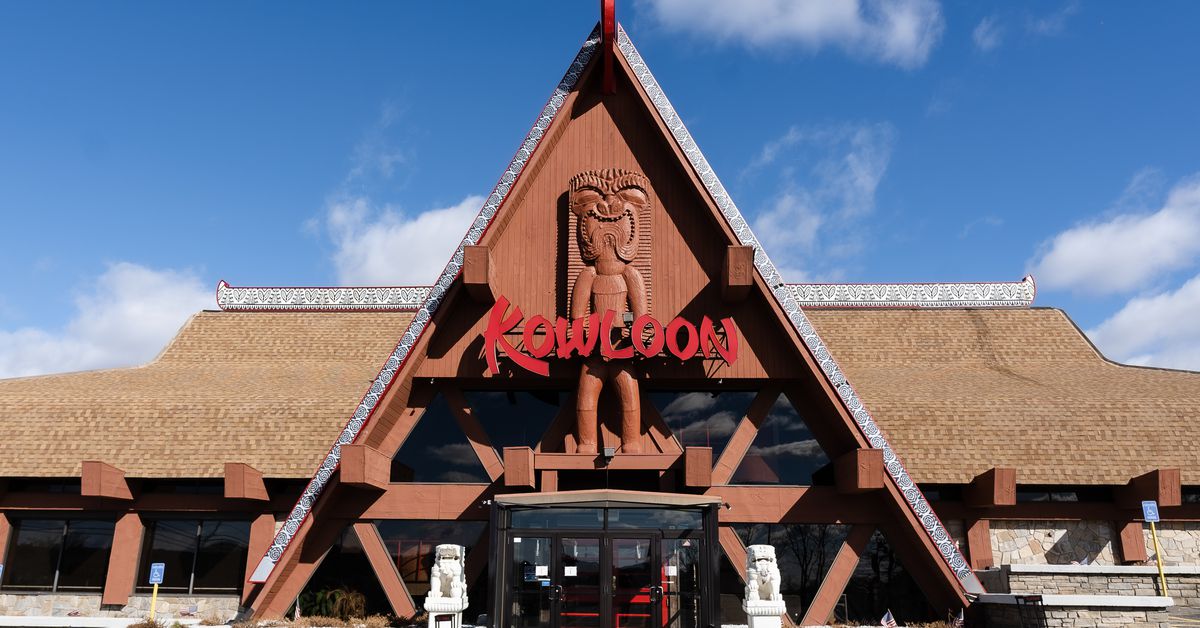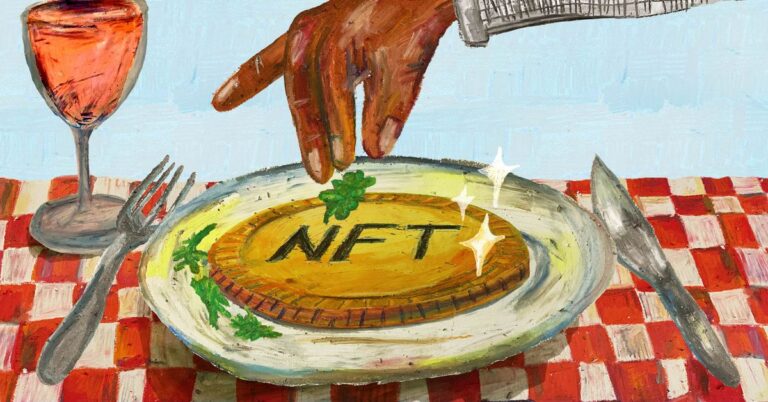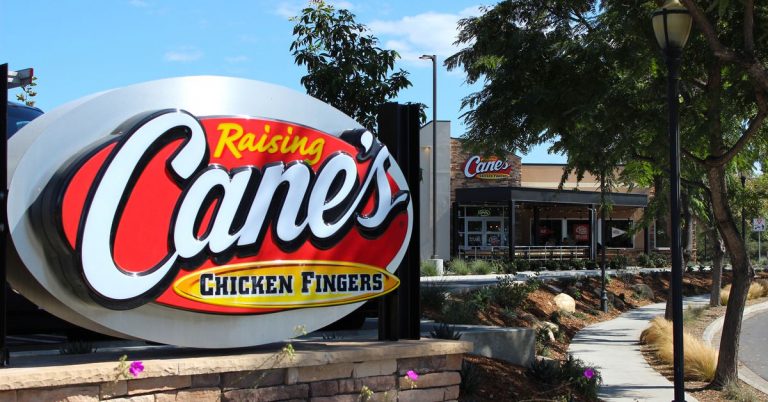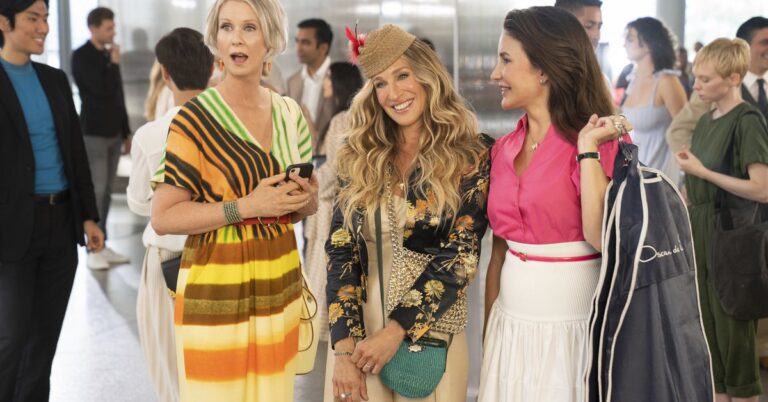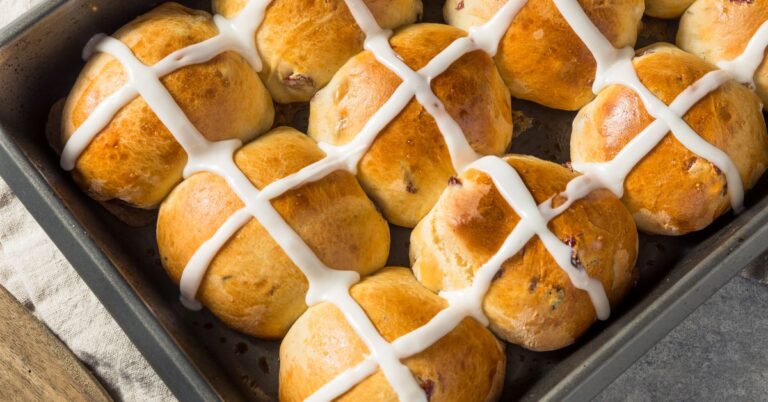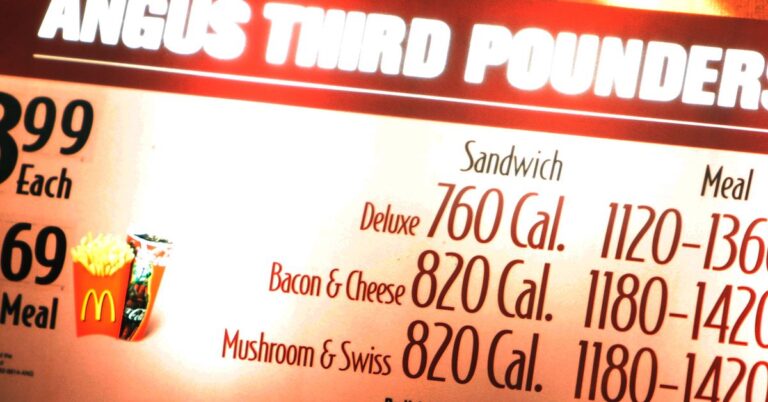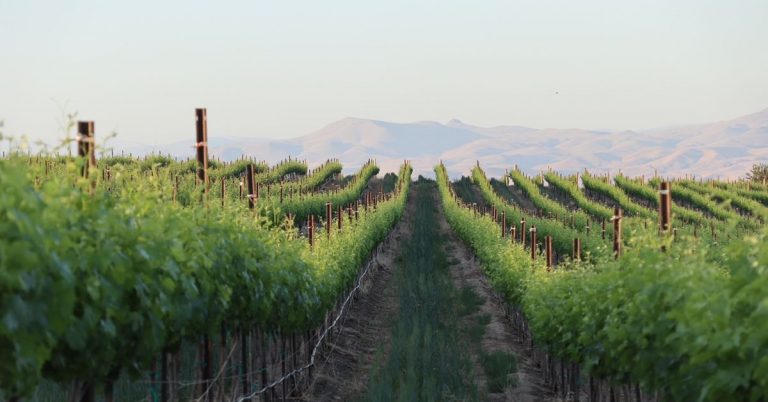An Ode to Kowloon and the Iconic Restaurants of Massachusetts’ Route 1
Every other weekend between 1988 and 1998, I became, as my fourth-grade teacher christened me, Miss Pan Am, jetting between Boston’s Logan Airport and LaGuardia’s Marine Air Terminal. I was born in New York City, and that’s where my father remained when my mother relocated to the north, where she grew up; Newburyport, Massachusetts, would become my adopted hometown.
A life like that sees a lot of repetition. For me, much of that trip played out on a strip of U.S. Route 1, all neon signs and strange attractions, when I sat as a passenger on the 48-minute drive between the airport and my mom’s home. But what’s still the most fascinating in my childhood memory is a gargantuan, totem-festooned restaurant called Kowloon, located on Route 1 just 10 miles north of the airport in a town called Saugus.
Kowloon has been in the news lately. They’re closing, or maybe they’re not closing, or they’re just talking about closing. Co-owned by the 94-year-old matriarch Madeline Wong; her personable son and the de facto face of the restaurant, Bob Wong; and Bob Wong’s siblings, Linda Chu, Donald Wong, Stanley Wong, Lisa Wong, and Andrew Wong, Kowloon has been open since 1950, and the restaurant is inextricable from this specific slice of highway, which spans roughly 15 miles from Malden to Peabody. It and the road together are cohorts of a midcentury driving and dining culture in a trio of neighboring Massachusetts counties: Essex, Middlesex, and Suffolk. Here is the beating heart of the North Shore (to avoid it, you’d have to take a maze of back roads), and so getting from place to place without driving alongside the attendant attractions would be nearly impossible.
As recently as the mid-’90s, the attractions were many. On the southbound side of the highway, in Saugus, near the Malden border, an orange dinosaur used to preside over the Route 1 Miniature Golf & Batting Cages, which had stood guard over speeding cars since the 1960s. Across the road, the late Frank Giuffrida’s Hilltop Steakhouse, founded in 1961 and once the largest-grossing restaurant in the world, with a 1,500-person capacity, has been closed since 2003, but its most important feature, a sky-high neon cactus, lives on. In 1930, a boat-shaped restaurant was built three miles north of Kowloon, in the town of Lynnfield; Italian joint Prince Pizzeria, not two miles from Kowloon, is outfitted with a very tall replica of the leaning tower of “pizza.”
My childhood was attached to these emblems: Given Route 1’s role as the North Shore’s through line, if you grew up in Massachusetts, you connect with its very existence. “It’s almost our own little World’s Largest Ball of Twine,” says food newsletter writer Josh Gee, who grew up in Lexington, Massachusetts. It’s a roadmap of the state, divorced from time and space, linking together past and present. Today, that orange dinosaur holds court over a soulless, gray apartment complex that faces the highway — and it feels gutting, one more chipping away of this slice of Americana. We have lost so many of our Route 1 icons. And although a dinosaur, or a neon cactus, or a leaning tower of pizza may feel purely like kitsch, these mementos may speak to what we needed then, and to what we may no longer need.
Kowloon is one of the last icons to grace this strip of highway. The restaurant — which is reportedly one of the top-grossing in New England — might be referred to as Kowloon or as the Kowloon, depending on who’s asking. (One of the owner’s sons, Nick Wong, offers no clarity on the issue: “I think it’s whatever people like to call it,” he says.) Kowloon, Bob Wong tells me, is not in danger of immediate closure. But in January 2021, Wong appeared at a meeting at the Saugus Planning Board to discuss possibilities for the restaurant’s future and triggered mass distress (and Mass. distress, as it happens).
:no_upscale()/cdn.vox-cdn.com/uploads/chorus_asset/file/23318477/March_8__2022_Kowloon_14.jpg)
Occupying 50,000 interior square feet and enough exterior square footage to seat, say, 500 people in the parking lot on a summer evening while screening a movie during COVID, Wong has prime real estate, should he and family choose to sell. And they do want to sell. Or sub-divide. Maybe not right now, but sometime soon: Wong won’t exactly say when. “It could be two, three years, and, who knows, it could even be five years,” Wong says in his distinct Saugus accent, hedging. “But we don’t know, so that’s where we’re headed.”
Kowloon was founded in 1950 by Wong’s Chinese-born maternal grandparents, Chun Sau Chin and Tow See Chin (his paternal grandparents, Goe Shing Wong and Lem Ding Wong, who owned May Fong Restaurant, near Boston’s Symphony Hall, stepped in at one point, too). It was a small restaurant that grew in both scale and importance, a dream that eventually became the North Shore’s own cavernous fantasia. Even if you never went inside, you imagined, driving by, what adventures lay in wait on the other side of those doors.
Here’s what you actually do see when you walk into Kowloon: a fountain, to your left. Hazy lighting. An ’80s-era bar, called the Hong Kong Lounge, to your right. Red, almost-but-not-quite threadbare carpeting. The seven total dining rooms have names: the Mandarin Room, the Tiki Lagoon Room, the Tiki Bar, the Volcano Bay Room, the aforementioned Hong Kong Lounge, and the combined Thai Grill and Sushi rooms. In the Tiki Lagoon Room, guests are seated around a massive water feature. Walk through and you’ll arrive at the Volcano Bay Room, where a replica of a ship is the piece de resistance. If you’re lucky, you’ll find yourself seated near the glowing volcano wallpaper, ever part of the luminescent experience.
William Wong, Bob and his siblings’ father, was the creative genius behind Kowloon’s escapist decor. The elder Wong, who died in 2011, converted the restaurant — once a tidy 40-seat spot — into the 1,200-seater it is today. He also imparted upon it his fabulist vision. “My mother and father were born in this country,” Bob Wong says. “But when my father was young, his father sent him to boarding school in China,” an international upbringing that piqued his interest in traveling the world. He continued to travel, filing away ideas and turning them into a fantasy dreamscape inside the restaurant.
The menu at Kowloon — though never entirely the point — offers a compendium of pan-Asian cuisine. The labyrinthine tome, heavy enough to subdue an enemy, could rival that of the greatest Greek diner. There is a sushi bar; a full roster of frozen drinks served in outrageous vessels; and the restaurant’s off-menu cult classic, Saugus wings (they are sticky and sweet). Platters are large. Inspiration is vague, borrowing from Singapore, Malaysia, China, and Japan.
“Our cooking style is not what you would see in Chinatown,” Bob Wong says. It’s worth noting here that Saugus is predominantly white; during the most recent census, which was conducted in 2020, the town’s population estimate was 90 percent white and 3.8 percent Asian. In the past, Wong says, Kowloon has hosted many Asian-style banquet events, though none since the start of the pandemic. But the Asian community that the restaurant draws casts a wider net, coming from cities like Malden and Lynn. “We have a very diverse customer base compared to years ago,” he says. “But this is just a reflection of the change in demographics everywhere.” Which is to say: Kowloon was never directing a menu toward any one specific audience.
Over the years, Kowloon has held on, even as other Route 1 stalwarts have crumbled under the weight of time. Hilltop Steakhouse has been closed for nearly two decades; that boat-shaped restaurant was torn down in 2017. There was once a 1950s-era cocktail lounge known as Caruso’s Diplomat on this same strip of highway, with an iconic neon sign. And what Massachusetts denizen could forget Weylu’s, the lavish Chinese restaurant perched on a hill that served extremely fancy food, housed an underground garage that could make Batman jealous, and lay abandoned for decades before falling victim to the wrecking ball in 2015?
:no_upscale()/cdn.vox-cdn.com/uploads/chorus_asset/file/23318485/March_8__2022_Kowloon_248.jpg)
:no_upscale()/cdn.vox-cdn.com/uploads/chorus_asset/file/23318487/March_8__2022_Kowloon_216.jpg)
“Kowloon is one of the most iconic restaurants in not only Massachusetts, but all of the Northeast, quite honestly,” says Bob Luz, president and CEO of the Massachusetts Restaurant Association. “I mean, there’s nobody that’s traveled the Northeast that is unaware of the Kowloon and its importance in the history of food and beverage in the greater Boston area.” But the places that live on are few and far between. Two notable strip clubs, DB’s Golden Banana (northbound) and Cabaret Lounge (southbound); Prince Pizzeria (southbound); and Kowloon (northbound) are almost all that’s left.
The Massachusetts restaurant scene, Luz concedes, is growing, and the fading garishness that is Route 1 is, in some ways, a victim of prodigious growth in the Bay State. During his nine-year tenure, Luz has seen growth of approximately $500 million in meal sales tax revenue. Even accounting for inflation, that number is staggering. “It’s been a very significant increase,” he says.
Massachusetts, the seventh-smallest state, has, according to Luz, the 10th-highest food and beverage volume in the country. More importantly, he says, local availability, smaller venues, and a change in dining habits are driving diners away from the Route 1 of yore. Yes, as Bob Wong will tell you, Kowloon is still busy, even on a Monday night in November. But Route 1 is changing. It has changed. A new moment has arrived, and it’s not quite clear what that moment looks like, with or without Kowloon at the helm.
The first time I remember actually visiting Kowloon was in the late 1990s, to see Dustin Diamond perform stand-up. Among its countless virtues, Kowloon also offers a fairly traditional comedy venue upstairs, at the Kowloon Komedy Klub, a room that opened three decades ago, high above the ersatz palm trees, boats, volcanoes, fountains, tiki decor, and lagoon. Some of the greatest comedians to grace the planet have gotten guffaws (or not) in that room, including Jerry Seinfeld, who, according to Bob Wong, was paid an undisclosed but allegedly very low rate to perform right before that famous television series launched. (Wong would happily invite Seinfeld back for the same rate today, he quips.)
What the comedy club at Kowloon is not is a gimmick; it’s highly respected by emerging and established comedians alike. “It’s a mainstay of the Boston comedy scene,” says Josh Gondelman, a Massachusetts native, comedian, and the writer and co-executive producer for Desus & Mero on Showtime. “I cannot overstate how badly I would bomb there … I would just eat it so hard. Three times out of three. Three times out of four. I got the worst heckle of my life there.”
New comedy clubs, of course, will open, as they always do. When Kowloon closes, something else, somewhere else, will take its place. But, Gondelman says, it’s not necessarily a one-to-one ratio. “I’m always rooting for more good comedy rooms,” he says. “But [a potential closure would be] such a blow to Route 1. It’s the thing people say about Manhattan: Everything cool closes down and becomes condos, or a bank.”
A restaurant with a comedy club that attracts big talent is more than just a place to eat food, and more than a kitschy place memorialized by nostalgia. Kowloon, in this sense, is a place of many communities: a community of nascent and established comedians, a community of locals, a community of kids who grew up starry-eyed at the idea of a 50,000-square-foot restaurant right there off of the highway, a community of immigrants who felt included in the narrative of an established and immigrant-owned business.
:no_upscale()/cdn.vox-cdn.com/uploads/chorus_asset/file/23318496/March_8__2022_Kowloon_265.jpg)
Now, these communities — these patrons who make up these communities — must grapple with their feelings about a very real and changing tide. There are countless memories baked into Kowloon’s sprawling footprint. A smaller Kowloon won’t be the Kowloon where people went year after year. Or it won’t be the place where you could see Jerry Seinfeld perform for a very affordable entry fee. Simply put: It won’t be Kowloon.
Debbie Turgeon, a former teacher from Saugus, got married at Kowloon, sort of. “We had our reception at Caruso’s Diplomat,” she says of her 150-person 1989 wedding. Later that night, she held her 200-person after-party at Kowloon. Turgeon offers a trove of stories: of the Wongs’ goodwill, of their quick-thinking response to COVID, of their largesse. “They are amazing to the community,” she says. “Amazing. If it comes to sporting events, hosting something, they’re giving you a discount. It doesn’t matter what it was.” She tells stories of the waiter who fell ill during the pandemic, but who remained on payroll regardless (according to Bob Wong, the restaurant employs 150 to 200 people); about her own family business’s holiday parties, which are held in the back room every year. “They went to peoples’ weddings, couples that worked at Kowloon,” Turgeon says of the Wongs. “It’s very intertwined.”
In this sense, Kowloon is part of a fading culture of family-run businesses that extended themselves beyond the confines of the brick-and-mortar of a physical building. You were family if you dined there regularly, family if you loved the restaurant the way the family who ran it did. There was a Route 1 businessman association, Bob Wong says, made up of local restaurateurs along the highway, like the Continental, the Hilltop, Augustine’s, Prince, and Caruso’s Diplomat. “We were all friends … There was a camaraderie among the restaurateurs.”
The Route 1 in my memory is an occasion destination. Turgeon, too, describes getting dressed up to go out to dine with her family, and the significance of dining on that stretch of highway. “It was an event to go out to dinner,” she says. Restaurants of this era and place had their own microcommunities. They were memory-makers, and the buildings themselves set the stage for parties and events and good times that would later span miles and lifetimes.
“For a lot of kids and families, Kowloon was a place you would go for everything,” says Josh Gee. “We would go after every single junior prom and have virgin strawberry daiquiris. I’d bring home a bunch of leftovers for my family.”
For the Wongs, though, Kowloon is part of a complex tradition of generational restaurants. Wong acknowledges this, tacitly, when he tells the story of its origin and discusses his own children’s reluctance to take over the day-to-day business. “Bob and Andy loved running it,” says Gee, who grew up with Nick Wong, one of Bob’s sons. “But none of their kids want to. And I think that’s one reason they’re looking at selling it.”
Of course, these migrations and closures are not all one thing, and whatever the reason, some argue that the authenticity of Route 1 hangs in the balance. For those of us who can remember that far back, it recalls nostalgia for Times Square when it was rough around the edges but still real. Maybe we’re all just a little thirsty for the way things used to be, blemishes and all.
Familiar, flushed-from-the-chill faces enter the Hong Kong Lounge to meet me for dinner at Kowloon: my 68-year-old Massachusetts-raised mom, Judith; my childhood friends, Mark (pronounced MAHK, in Massachusetts parlance), JR, and Thom; and my two attendant spouse-friends, Ben and Jenny. The last time we gathered together inside like this had been in March 2020 to celebrate Mark’s 40th birthday. That was exactly six days before the lockdowns began.
And so in some ways, this meal — inside, and together at long last — is a celebration of so much. Most of us are over the hill now, safely in middle age. Many of us have kids. It occurs to me, mid-meal, that this may be the last time that any of us sets foot in this place, in this ship room, right near the volcano wallpaper. Jenny orders the pupu platter and the Saugus wings, which are, indeed, sticky and mall-food-good. I order a $20 pina colada that comes in a carved-out pineapple.
Dining here feels like a last hurrah, a final celebration as we pass massive platters around the table: Who knows what will stand in this space the next time we think of dining here? After dinner, I take my life in my hands and turn into oncoming traffic on Route 1, a blur of headlights heading north. I pass a McDonald’s, numerous Dunkin’ Donuts, a brand-new Jersey Mike’s. The old Square One Mall, on the southbound side, is still there, barely holding on. There are more gas stations than I remember, fewer oddities.
The magic of Route 1 does seem to be fading, one extinguished restaurant at a time. I think, though, of something that Bob Luz said: “Kowloon is eternal; it is the flame that will never go out.”
It’s still unclear how long that will last. Bob Wong has gone before the Saugus Planning Board many more times, including right after I met with him in November. The subdivision he has proposed includes two lots: a commercial space — a smaller version of the existing restaurant, to hear Bob Wong tell it — and two six-story structures.
But for now, Kowloon lives on. And Bob Wong, for better or worse, seems optimistic. This highway, he says, was the American Dream, and Kowloon was its ultimate manifestation. And now it is realized, the story written. “That’s how America is,” he says. “You can come here and go for the American Dream, no matter who you are. My father, mother, and my grandparents were proof of that.” That resounding legacy — and not whatever apartment complex comes after — is the memory he hopes we hold.
Hannah Selinger’s IACP Award-nominated work has appeared in The New York Times, Travel + Leisure, The Wall Street Journal, Wine Enthusiast, The Washington Post, The Boston Globe, and elsewhere. Sophie Park is a freelance photojournalist based in Cambridge, Massachusetts.
